imported>Lochbrunnera |
imported>Lochbrunnera |
||
| Line 221: | Line 221: | ||
The historiography regarding expellees has not only seen its ups and downs (special interest until the end of the 1950s, repression until the 1980s, because the subject had been dealt with and seemed politically undesirable, then new attention in the context of general migration issues), it has also always been shaped and endangered by massive ideological and political influences (nationalism, Cold War, criticism of conservatism), some of which are still fighting against each other (e.g. Nawratil; Hahn). The dispute over a "Centre against Expulsions" in Berlin has brought about new discussions since 1999. It is therefore precisely in this area that we must work to ensure that all views presented in an appropriate manner are always given serious consideration. | The historiography regarding expellees has not only seen its ups and downs (special interest until the end of the 1950s, repression until the 1980s, because the subject had been dealt with and seemed politically undesirable, then new attention in the context of general migration issues), it has also always been shaped and endangered by massive ideological and political influences (nationalism, Cold War, criticism of conservatism), some of which are still fighting against each other (e.g. Nawratil; Hahn). The dispute over a "Centre against Expulsions" in Berlin has brought about new discussions since 1999. It is therefore precisely in this area that we must work to ensure that all views presented in an appropriate manner are always given serious consideration. | ||
The collection of historical data and examination of the subject began soon, both in Germany and Bavaria. Large source works (e.g. documentation of the expulsion) and a three-volume handbook (Lemberg-Edding) laid the groundwork until 1960. The activities by Professors Friedrich Prinz (Munich) and [[Person:122437519|Rudolf Endres]]{{#set:PND=122437519}} ([[Ort:ODB_S00038624|Bayreuth]]{{#set:OID=ODB_S00038624}}, born 1936) were of particular importance for Bavaria, as was the publication series from the Ministry of Labour (Prof. [[Person:101046782|Hermann-Joseph Busley]]{{#set:PND=101046782}} [born 1930], Entwicklung Bayerns). Since the 1990s, the topic has primarily been examined across countries and social groups (e.g. Krauss, Integrationen; Teuchert, Gemeinschaft). The influence of well-known films (e.g. Grün ist die Heide, 1951; Heimatmuseum, 1988), which of course usually showed less the expulsion than the successful integration (Tiews, Fluchtpunkt), is also noteworthy. One pleasing development is that a proper handling of the events has meanwhile even begun in the former expelling states, with regard to both the expulsion itself and to the problems of reconstruction, for example in the borderlands of Poland and the Czech Republic. This also broadened German researchers' view to neighbouring areas (e.g. Hofmann; Wiedemann), just as the establishment of the Euregions (e.g. Euregio Eger) has already done in the social sphere. Fundamental discussions on folklore and nation building, as they have been conducted for several decades, are also important. Expulsion as a secular process has found considerable interest in the public again as a result, although the earlier euphoria that integration had been totally successful tends to be called into question. In addition to scientific works and non-fiction books, there is a large number of books about the homelands and personal memoirs that should not be underestimated. They are collected by the libraries and archives at the Haus des Deutschen Osten and Sudetendeutschen Haus or the [[artikel_46278|Bayerisches Hauptstaatsarchiv]] (Main State Archive of Bavaria), which also preserves the holdings of the Sudeten German Archive. It is also worth mentioning the many "Heimatstuben" (homeland museums) and homeland collections. Although these were built and equipped in the spirit of the post-war period, they offer excellent material for the individual expulsion regions, from letters and writings to pictures and traditional costumes (cf. Henker; Eisler); as more and more of these are being broken up today, following the end of the generation with personal experiences, special attention must be paid to the preservation the material in other places, such as archives and museums in Bavaria and Bohemia (Sauer, Nachrichten). | The collection of historical data and examination of the subject began soon, both in Germany and Bavaria. Large source works (e.g. documentation of the expulsion) and a three-volume handbook (Lemberg-Edding) laid the groundwork until 1960. The activities by Professors Friedrich Prinz (Munich) and [[Person:122437519|Rudolf Endres]]{{#set:PND=122437519}} ([[Ort:ODB_S00038624|Bayreuth]]{{#set:OID=ODB_S00038624}}, born 1936) were of particular importance for Bavaria, as was the publication series from the Ministry of Labour (Prof. [[Person:101046782|Hermann-Joseph Busley]]{{#set:PND=101046782}} [born 1930], Entwicklung Bayerns). Since the 1990s, the topic has primarily been examined across countries and social groups (e.g. Krauss, Integrationen; Teuchert, Gemeinschaft). The influence of well-known films (e.g. Grün ist die Heide, 1951; Heimatmuseum, 1988), which of course usually showed less the expulsion than the successful integration (Tiews, Fluchtpunkt), is also noteworthy. One pleasing development is that a proper handling of the events has meanwhile even begun in the former expelling states, with regard to both the expulsion itself and to the problems of reconstruction, for example in the borderlands of Poland and the Czech Republic. This also broadened German researchers' view to neighbouring areas (e.g. Bretschneider; Hofmann; Wiedemann), just as the establishment of the Euregions (e.g. Euregio Eger) has already done in the social sphere. Fundamental discussions on folklore and nation building, as they have been conducted for several decades, are also important. Expulsion as a secular process has found considerable interest in the public again as a result, although the earlier euphoria that integration had been totally successful tends to be called into question. In addition to scientific works and non-fiction books, there is a large number of books about the homelands and personal memoirs that should not be underestimated. They are collected by the libraries and archives at the Haus des Deutschen Osten and Sudetendeutschen Haus or the [[artikel_46278|Bayerisches Hauptstaatsarchiv]] (Main State Archive of Bavaria), which also preserves the holdings of the Sudeten German Archive. It is also worth mentioning the many "Heimatstuben" (homeland museums) and homeland collections. Although these were built and equipped in the spirit of the post-war period, they offer excellent material for the individual expulsion regions, from letters and writings to pictures and traditional costumes (cf. Henker; Eisler); as more and more of these are being broken up today, following the end of the generation with personal experiences, special attention must be paid to the preservation the material in other places, such as archives and museums in Bavaria and Bohemia (Sauer, Nachrichten). | ||
==References== | ==References== | ||
Revision as of 12:39, 30 August 2021
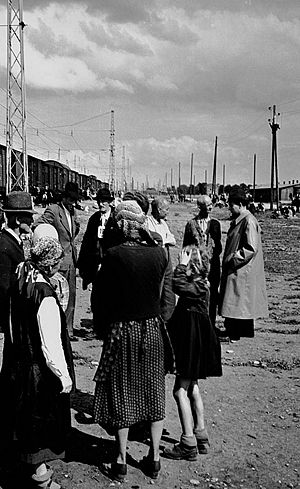
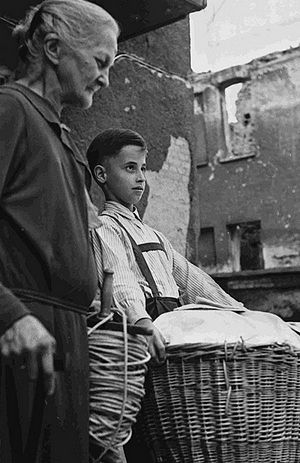
Of the approximately 12 million German citizens and German-speaking minorities who had to leave their homes after the Second World War, 1.9 million (1950) came to Bavaria, each one with individual historical roots and specific experiences of flight and expulsion. Other groups (e.g. refugees from the Soviet occupation zone) came later. Their reception, distribution, accommodation in housing and work as well as their social and cultural integration posed a great challenge for Bavaria; on the whole, it was well resolved. For the expellees this was a basic fate of change, as they had lost their ancestral homeland and their entire living environment; but Bavaria also changed considerably due to the large number of new citizens with different traditions.
Historical Background
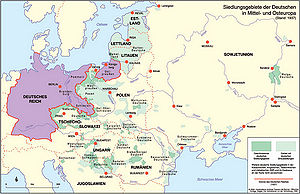
After the Second World War, approximately 12 million German and German-speaking inhabitants of the states in Eastern, Central Eastern and South-Eastern Europe were forced to leave their homelands, either by fleeing due to the events of the war or by expulsion ordered by the state. About 7.9 million of these had to be taken in by the western zones of defeated Germany (since 1949 Federal Republic of Germany [FRG]), 4 million in the eastern zone (since 1949 German Democratic Republic [GDR]). Several hundred thousand people came to Austria and other countries. Around 1.9 million came to Bavaria. In addition, there were also evacuees (about 468,000), former prisoners of war and forced labourers ("Displaced Persons", about 360,000), refugees from the Soviet occupation zone (SBZ) or the GDR (by 1955 about 281,000) and late repatriates (1951/1961: about 362,000, mainly from Poland), finally the few but very influential returnees from the group of intellectuals and politicians who had gone into exile since 1933. However, they were very few; they are therefore not comparable to the expellees. Overall, expulsion and admission represent a secular change in the demographic structure of Germany and Bavaria.
Terminology
When naming the case and the persons concerned, a distinction must be made between colloquial language and public discussion on the one hand and official definitions on the other. In general discussion, the words "flight" and "expulsion" as well as "refugees" and "expellees" have rightly come into line and are used as a common term, because the flight from the Red Army in the East since the beginning of 1945 was not voluntary. It also soon lead into a phase of "wild expulsions" before and after capitulation, which were initially forced illegally by partisans, then soon by the government and army, too, until the official forced resettlement began seamlessly still in 1945.
In addition, there were soon attempts to officially define the terms. In West Germany, the Federal Expellee Law (May 19, 1953) introduced the word "expellees" as a collective term for all those who had to leave their homeland in the East, but designated the population once living there as "homeland expellees" (deadline December 31, 1937). The word "refugees" was reserved for those who had fled the Soviet Union/GDR. The expelling states, whose communist governments were dependent on the Soviet Union, claimed that the events were legal. They soon tried to avoid the issue altogether and did not speak of expulsion in any case, but used "transfer" or corresponding words (e.g. Czech: Odsun = evacuation). The GDR committed itself to "resettlement" and "resettlers".
Reasons for Expulsion, Legal Situation
Attributing the expulsion just to the Second World War triggered by the German Reich with its crimes, does not go far enough. The expulsion has rather long-term causes, namely in the nationalism of the 19th century, whose radicalisation often led to plans and attempts at "ethnic cleansing", either through national alignment of the minorities or through their expulsion to the point of extermination (Examples: population exchange between Turks and Greeks after the First World War in 1923; resettlement of the South Tyroleans or the Baltic Germans since 1939; genocide of the Armenians in the Ottoman Empire during the First World War; cf. Ther, Außenseiter). The climax, of course, was the National Socialists' racist crimes and the displacement of peoples by the Soviets. But there were old traditions of the struggle of population groups elsewhere too, each with radical proposals for total assimilation or expulsion. Such tendencies already became visible in Prussia at the end of the 18th century, after the partition of Poland in 1772/95, as the Germanisation of the Polish and other population groups driven by the administration, in Poland since about 1830 as intentions to uniformly polonise the state to be established in the future (Gehrke, Westgedanke, e.g. 119f., 284), which admittedly had to remain just thoughts and plans until 1918 and could only be tried in reality then. There had been particularly fierce battles in Bohemia since 1848. In this case it had a particularly radicalising effect for both sides that German Bohemia had been forcibly integrated into the new Czechoslovak state in 1918/19 and that they later participated in its destruction in 1938/39 and largely cooperated with the Nazi occupiers (Munich Agreement 1938, Protectorate). With regard to the events after 1945, it is therefore necessary to examine both the intentions of the victorious powers (in the case of the Western powers, for example, the argumentation with the Greek-Turkish exchange played a major role) and the long-term or short-term historical reasons for the expulsion in each individual country.
Expulsion was indeed a means of revenge and retaliation for the war caused by the Germans, its crimes and terrible consequences, and represented also a political calculation of the victorious powers for the future. But there was no automatism. Not all the victorious powers expelled the Germans: there was no expulsion, for example, in France (Germans in Alsace), only a small one in Romania (Transylvania); the Soviet Union deported its Germans but did not expel them (except in former East Prussia).
The expulsion from Poland, Czechoslovakia (ČSR) and Hungary was given a political basis (only for these states) by the Potsdam Agreement between the victorious powers on 2 August 1945, Article XIII, which recognised that "the transfer to Germany of the German population, or parts thereof, remaining in these countries must be carried out". While this stipulation, which Yugoslavia and, in part, Romania also made use of without justification, was always used as justification for the expulsion, the expelling states almost completely refrained from the two conditions also formulated there, namely that the expulsions had to be suspended for the time being until the future distribution had been regulated, and that every "such transfer that will take place should be done in an orderly and humane manner". In view of the actual situation, these formulations have even been described as "cynicism" or "self-deception of breathtaking proportions" (Douglas 121f.). Moreover, since the conference could not reach an agreement on Germany's eastern borders, Poland and the Soviet Union saw the German eastern territories they occupied as parts of their own states and also expelled the Germans from the territory of the Reich, a unique event in modern history.
As far as the legal situation is concerned, before 1918 the expulsion of the own population by a state was not an issue of international law, as it had been unknown until then. It was not until the Turkish-Greek forced resettlements of 1923 that the discussion began, which quickly led to the condemnation of such expulsions. Deportation was already a "crime against humanity" for the 1946 Nuremberg War Crimes Trial. However, the prohibition of expulsions was only laid down in international law in the Fourth Additional Protocol of 1963 to the European Convention on Human Rights of 1950 ("No one may be expelled from the territory of the State of which he is a national by means of an individual or collective measure"; "Collective expulsions of foreign nationals are not permitted"). However, due to the development of international law, this can already be regarded as a general conviction at the time of the expulsions (Kimminich, Hintergrund, 241). Today, "deportations or forced population transfers" are branded war crimes and crimes against humanity according to the Statute of the International Military Tribunal in The Hague (1998).
Origin: Figures and Traditions
Since Bavaria had a share of the expellees from all countries, their total must also be considered. The table gives rough information about the origin of the expellees (borders 1937; various census years before 1939; rounded figures): (Reichling, Vertriebenen 1, 17 ff.; Bayern in Zahlen, issued 1952)
| Country | German and German minorities (1939/1945) | Share of German mother tongue (%) in the state nation before 1939 | Expelled | Came to Bavaria | Share in Bavaria (%) |
|---|---|---|---|---|---|
| The Reich's Eastern territories (Prussia) | 9.575.000/ 9.075.000 | 6.987.000 | 592.000 | 31,8 | |
| of these from: East Prussia | 2.473.000 | 80 | 1.890.000 | 87.000 | 4,6 |
| of these from: East Brandenburg | 642.000 | 100 | 410.000 | 13.000 | 0,7 |
| of these from: East Pomerania | 1.884.000 | 99 | 1.470.000 | 34.000 | 1,8 |
| of these from: Silesia | 4.576.000 | 77 [Upper Silesia 61] (Polish 11, bilingual 28) | 3.210.000 | 458.000 | 24,7 |
| Czechoslovakia | 3.544.000/3.496.000 | 22,5 (Czech 50,5; Slovak 15,7) | 3.055.000 | 1.025.000 | 55,2 |
| Poland | 1.200.000/2.370.000 | 4,5 (Polish 68,9) | 1.405.000 | 48.000 | 2,5 |
| Soviet Union | 1.400.000 | 0,73 (Russian 60) | 980.000 displaced | 10.000 | 0,5 |
| Gdansk | 380.000/388.000 | 96,5 | 305.000 | 11.000 | 0,5 |
| Yugoslavia | 536.000/435.000 | 4,3 (Serbo-Croatian 74,4) | 283.000 | 66.000 | 3,5 |
| Hungary | 600.000/518.000 | 5,5 (Hungarian 92,1) | 210.000 | 49.000 | 2,6 |
| Romania | 782.000/498.000 | 4,1 (Romanian 71,9) | 133.000 | 45.000 | 2,4 |
| Baltic States: Latvia, Estonia, Lithuania; Memelland | 250.000/100.000 | 3 (Latvian 75); 1,5 (Estonian 88); 1,4 (Lithuanian 84,2); Memelland 51 (Lithuanian 48) | 72.000 (127.000 displaced) | 8.000 | 0,4 |
| Total | 18.267.000 | 12.450.000 | 1.854.000 |
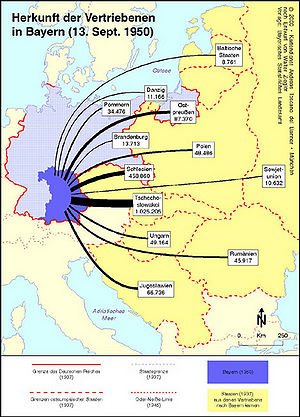
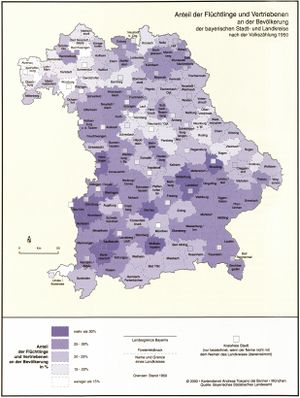
Most of the expellees came from the German territories beyond the Oder and Neisse rivers, i.e. from the German Reich. They were basically German citizens. The German-speaking minorities in Eastern, Central Eastern and South-Eastern Europe, on the other hand, were nationals of other states, especially those that had established themselves as nation states after the First World War. They had received German citizenship only after the occupation by the Nazi Reich and only in part.
As far as Bavaria is concerned, the Germans from Czechoslovakia, i.e. Sudeten Germans (from Bohemia, Moravia, "Austrian" Silesia) and Carpathian Germans (from Slovakia and Carpathian Ukraine), made up the clear majority, namely 55.2% of all expellees (Silesians 24.7%, East Prussians 4.6%). But also the majority of Germans from Yugoslavia, Romania, the Baltic countries and the Soviet Union (about 6% of the expellees) found their new home in Bavaria.
Due to the different origins, it is problematic to simply speak of the "expellees" as one unit. It was precisely among the minority Germans that people with the most diverse national and cultural traditions came to Germany, and the Germans from the eastern territories of the Reich also differed considerably from each other and from those in the host regions. Therefore, the individual groups' self-image and the later integration with its problems can only be grasped if one knows about their respective history and culture before the expulsion. For the Sudeten Germans, for example, the language and school dispute since 1918 and the rise of Konrad Henlein's (1898-1945) "Sudeten German Party" since 1935 were of the greatest importance; cultural leading figures among them were the writer Adalbert Stifter (1805-1868) or the car designer Ferdinand Porsche (1875-1951). Among the Silesians, the vote in East Upper Silesia and the battles for the Annaberg in 1921 were vivid memories; their leading figures included the writer Joseph von Eichendorff and Breslau Modernism in architecture. The Danube Swabians in Yugoslavia, Romania and Hungary also had equally deep ties with their homeland's history and traditions (e.g. Gottschee, Banat, Batschka: until 1918 Austria-Hungary).
Flight and Expulsion – Events and Experiences
The experiences of forcibly leaving one's homeland have deeply influenced people. Their individually highly diverse experiences were determined by specific events ranging from simple relocation to camp confinement and transport to wild chases and massacres. The most important events were first of all the evacuations in the Eastern territories since 1944, which were still initiated by the German authorities and mostly took place in joint treks, often immediately before and already during the Soviet conquest. Numerous rapes and flight across the Baltic Sea were among the most well-known and particularly tragic incidents (e.g. sinking of the ship "Wilhelm Gustloff" on 30 January 1945, more than 9,000 dead).
At the end of the war - for Bavaria the events in ČSR are considered here - unauthorised wild expulsions took place first, which were mainly called for by Czech Revolutionary Guards. Then, as early as the end of May 1945, also before the decision of the Allies, the government ordered so-called "wild" expulsions, carried out by the army, mostly to the Soviet zone (Arburg, Deutschen, 195-196). Both led to outrageous excesses in some places (Brno death march 30 June/12 July 1945; Aussig drownings 31 July 1945). In the summer and autumn of 1945 the "legally" state-organised expulsions began, which were carried out extremely rigidly but more regulated by the "National Committees" (národní výbor). Admittedly, also in this case the order to leave home on the spot with 30 to 50 kg of luggage, the hunger in the camps, to some extent forced labour and finally the days of transport to Germany in cattle wagons made a mockery of the demanded humane standards. It is also deeply imprinted in people's memories that the Germans were now discriminated against by a white armband with the imprint N (Němec = German) and by many prohibitions in their former homeland. Among the experiences was also the bitter realisation that the officials and authorities there were not putting a stop to this but were often rather driving it, and that even church institutions did not raise one word of protest. However, personal assistance was offered time and time again and was by no means rare among the population in these countries, and shame was expressed about the events. All this was soon proved in large documentions.
The conditions in Poland differ in some respects from those in ČSR. First there were a large number of returnees who had fled the Soviet conquest. Then there was a longer and different phase of living together - now in bitterness - with the new Polish population, which in turn had been expelled from the eastern Polish territories annexed by the Soviet Union. The fact that the Soviet and Communist Polish governments always (untruthfully) claimed that the majority of Germans had fled and left their property deprived them of any protection. The nationalistic polarising aspect was also more significant. The Catholic church organisation was also one of the agitators in order to create a unified Polish church and at the same time to push back the Protestant church, which was regarded as German (Nitschke, 149-164).
Only later did it become clear to people that - contrary to international law - their entire property had been taken away from them (in the ČSR: Beneš Decree No. 5 dated 19 May 1945 on the "National Administration of the Assets of the Germans, Magyars, Traitors and Collaborators" [Odsun, Expulsion 2, 549-551]; in Poland: among others laws dated 6 May 1945 and 3 January 1946) and any return to their homeland, as it was initially intended as a matter of course, was impossible.
Not all Germans were expelled everywhere. In Upper Silesia, for example, there had been a large solely Polish-speaking or bilingual minority, some of whom had declared themselves as Germans in the Third Reich, but now as Poles or as "indigenous" (natives), so that a considerable number of solely German-speaking or bilingual German speakers remained in the country here (1947 in new Poland: approx. 298,000 Germans and approx. 1,057,000 indigenous). In Czechoslovakia, it seemed at first that the so-called antifascist Germans who had fought against Adolf Hitler (1889-1945) and for ČSR would be allowed to stay but they soon had to leave the country as well. The voluntary relocation transports organised by the socialist Alois Ullmann from Aussig, which brought over 70,000 Social Democrats to the West, mainly to Bavaria, partly with Czech help (most of them well supplied with household goods; cf. Vergnon, Sozialdemokraten, 118-162) are of particular interest here. A small number of skilled workers (e.g. in the Gablonz jewellery industry) were also held back at first, and finally there were Germans who remained in the country for various reasons - also simply due to the progression of time (1950: approx. 230,000; official statistics): 159,138).
For decades there have been factual and methodical disputes about the Germans who died after the end of the war and during the expulsion (Beer, Flucht, 127-134). The figures range from 2.8 million (including 272,000 in the ČSR: Nawratil, Schwarzbuch, 73-75) to 1.4 million (ČSR 216,000: Reichling, Vertriebenen 1, 36) to well below 1 million (Beer, Flucht, 134; Schwartz, Säuberung, 562). The balance sheet of the Federal Archives, drawn up in 1974 and published in 1989, lists more than 600,000, excluding the Soviet Union, Yugoslavia and Romania (ČSR 130,000: Vertreibung und Vertreibungsverbrechen, 53). The displacement losses in the case of ČSR are particularly controversial. While Reichling and others include the missing and unsolved cases, the German-Czech Historical Commission, founded in 1990, wants to resort to the officially registered deaths as far as possible and postulates 15,000, at most 30,000 victims (Stellungnahme, 603). Both points of view are alleged to have an apologetic tendency in favour of their clients. Since the ČSR's impunity law of 1946 declared all crimes that had taken place in the course of "regaining freedom" or in "just retaliation for the occupiers' and their helpers' acts" up to 28 October 1945 to be exempt from punishment, there has been hardly any judicial processing of such excesses to date (Brandes, Lexikon, 652); In the meantime, however, reference should be made to Padevĕt's documentations of individual and institutional terror at the end of the war (for the Germans especially his work „Blutiger Sommer 1945"). Altogether one can sum up with Schwartz (Säuberung, 578): "Even though there were worse things than the expulsion of Germans after the Second World War, the acts of violence associated with this greatest ethnic "cleansing" in modern history should nevertheless be clearly seen."
Arrival and Distribution
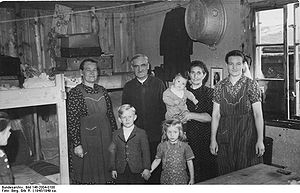
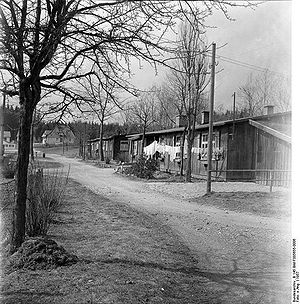
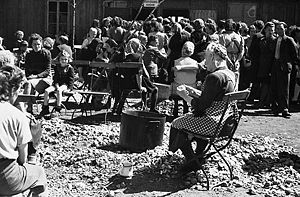
Although about 734,000 refugees had sought refuge in Bavaria alongside evacuees and displaced persons (DPs) by 1945, and a considerable number of expellees were sent here even later (about 128,000 in 1947), the majority arrived in Bavaria in 1946. During that year, there were 764 organised transports with 777,130 expellees from CSR. They arrived via six border transit camps of which Wiesau (district of Tirschenreuth) and Hof (Saale) in the north, Furth im Wald (district of Cham) in the east and Piding near Reichenhall (district of Berchtesgadener Land) in the south of Bavaria were the most important. The crucial issue for the Allies, then the US military government and the Bavarian government was the distribution of expellees in general and especially in the state of Bavaria. By the end of 1946, it had taken in some 1.9 million people (an increase of 28% over 1939), making it one of the most important receiving German states alongside Schleswig-Holstein (1 million, 67%), Mecklenburg (734,000, 52%) and Lower Saxony (1.8 million, 42%) – the French zone (e.g. Rhineland-Palatinate) did not take in any expellees at all at first.
For the distribution in Bavaria itself, which was carried out under State Commissioner Wolfgang Jänicke (1881-1968, former district president in Wrocław) appointed on 14 December 1945 by five government commissioners and 166 refugee commissioners in the districts, there would have been various possibilities (e.g. sorted by former residential communities or regions, by denominations, in a part of the country to be evacuated by the natives), but this could hardly be discussed in light of the urgency. Even the attempt to keep the administrative district of Lower Bavaria/Upper Palatinate, already heavily occupied, or tourist resorts free was not feasible. What remained was distribution to areas with little destruction, i.e. mainly in the countryside. This was done through (intended temporary) accommodation in all kinds of buildings and in many refugee camps (October 1946: 1,381 camps with 151,113 people, more than 20 camps with more than 6,000 inhabitants in Munich alone; even former concentration camps were used for this purpose); alternatively, expellees were (compulsorily) transferred to the locals' homes.
The expellees were therefore indiscriminately scattered across Bavaria. Nevertheless, focal points did emerge: by October 1946, most Silesians had found accommodation in Upper Franconia (42% of all expellees in the administrative district) and Lower Bavaria (37%), as had a large number of East Prussians. By contrast, many Sudeten Germans in particular had ended up in Swabia (195,000 = 71%), although even more had arrived in Upper Bavaria (208,000 = 54%). Upper Bavaria had the most new citizens as the largest administrative district but they only made up 16% of the population here (Lower Bavaria 24%). In Bavaria as a whole, the figure was 20% at the beginning of 1955 (23% with the Soviet occupation zone and GDR refugees).
The reasons for this specific distribution are complex and still need to be clarified. They range from the arrangement of transports in the home country to families' and acquaintances' own initiatives, then to the authorities' distribution plans and to the activities of individual mayors, district administrators, etc. in order to get certain groups into their region, for example the members of the famous Gablonz jewellery industry, which several districts endeavoured to acquire and which were finally concentrated mainly in Swabia (Kaufbeuren, town district of Neugablonz). The five Bavarian refugee communities (besides Neugablonz: in Upper Bavaria Geretsried [Bad Tölz-Wolfratshausen district], Waldkraiburg [Mühldorf am Inn district] and Traunreut [Traunstein district], in Upper Palatinate Neutraubling [Regensburg district]), whose large number is a specific feature of Bavaria, belong in this context. Built on former Wehrmacht grounds, they represent an outstanding concentration of expellees, thus contradicting the victorious powers' requirements for the complete integration of the new inhabitants into the German population.
The distribution and specific figures changed a little over the next few years. This was due on the one hand to the fact that people taken to farmland soon started to aspire to move to the cities, on the other hand also to the resettlement to other West German states set in motion by the Federal Republic and Bavaria, which caused over 200,000 people to move away, mainly to Baden-Wuerttemberg and North Rhine-Westphalia. Independently undertaken relocations were admittedly twice as high. On the other hand, there was only a small emigration to the USA – the hope cherished by some that this would solve the problem of expellees was a delusion. All these movements had to take place voluntarily; Americans as well as Germans definitely did not want another forced resettlement.
Work and Housing, Disputes
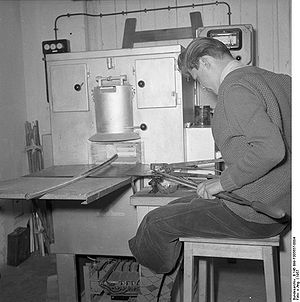
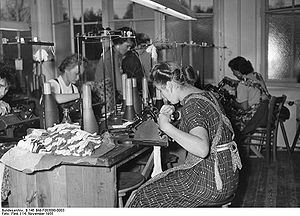
Contrary to expectations, it was possible to get the majority of the expellees into work quite soon: The new citizens, many of whom were very well educated in crafts and industry and often even superior in school education, quickly found employment, especially as they were prepared to take on any job straight away. The economic rise of the western zones supported this. After 1951 many former civil servants also returned to a state position (on the basis of Article 131 of the Basic Law for the Federal Republic of Germany, which also made the integration of former NSDAP members possible). Admittedly, only a small proportion of the expellees were able to return to the same profession, with the farmers having the hardest time of it; older people had little chance anyway. Unemployment also hit the refugees hard at times; in their case not at the beginning, but later, especially after the currency reform in June 1948 (Beiträge zur Statistik Bayerns, Die Vertriebenen in Bayern, 12). Nevertheless, the placement in work was very successful overall. By the way, the large number of expelled teachers (1950: 28% of full-time primary school teachers) and university teachers (in Munich mainly those from Wroclaw) who worked here was notable. The swift economic integration can also be seen in important refugee companies, of which only Müller's Karlsbader Backpulver (Neutraubling) or the Kunert stocking factory (Immenstadt [Oberallgäu district], formerly Warnsdorf/Bohemia) shall be named for Bavaria, in addition to the rapidly rising (Neu)Gablonz industry. This was also helped by loans from the Landesanstalt für Aufbaufinanzierung (Bavarian State Institute for Development Financing), which were guaranteed by the State.
The provision of housing was much more difficult – there were still 465 state refugee camps (over 90,000 people) in 1949, the last ones were only dissolved in 1957. As housing construction only started slowly, local residents were in most cases forced to accommodate refugees and expellees in their homes by the (therefore often hated) refugee commissioners, which resulted in extremely confined space for everyone, but especially for those who were assigned (in 1950 only 30% had their own kitchen, 51% had just one cooker in their room, 17% had to use the home owner's kitchen or had no cooking facilities at all; it was even worse in the big cities: 23/39/35%). The fact that many refugees arrived without furniture and without any household goods and also had no money for rent was another difficulty.
For this reason, there were considerable differences between expellees and locals, especially at the beginning. The forced assigned accommodation, the clash of different traditions from dialect to food, the changes in professional life due to the high activity of refugees and their state support, all this gave rise to displeasure, envy and concern about alienation, which could be expressed severely both verbally and physically. For their part, the refugees, who often looked down on an allegedly backward country, often considered themselves simply rejected. However, one has to be very careful when evaluating such disputes, because there was a lot of personal help from the locals too. In any case, there were no serious attempts to deport the refugees or a part of them (the "Prussians").
Help and Self-Help
The influx of expellees called for help. At first, institutions such as the Red Cross, Catholic Caritas and Protestant Diakonie as well as newly emerging relief organisations intervened, albeit with only small funds in the situation at that time. Then the new government took action in Bavaria very soon. A special administration was already established at the beginning of the new year, with State Commissioner (from 31 January 1947 State Secretary) Wolfgang Jänicke heading it (until its dissolution in 1950). The office was under the control of the Ministry of the Interior, but acted very independently. After 1950, the Ministry of Labour was (and is to this day) responsible for matters concerning expellees (today: Bavarian State Ministry of Labour and Social Affairs, Family and Women). The establishment of the "Hauptausschuss der Flüchtlinge und Ausgewiesenen" (Main Committee for Refugees and Exiles) in Munich (24 August 1946) with 15 party representatives was just as important. The US zone's refugee law (February 19, 1947) put refugees on an equal footing with natives. The problems were often intensively discussed in the Landtag, for example the spectacular protests and camp revolt in Dachau in August/October 1948 in view of very bad accommodation and food conditions there (Prinz, Integration 1, 264-270). In addition, efforts by the emerging West German central authorities (since 1949 federal authorities) must be mentioned, which led to the Immediate Assistance Act of 1949, and then to the large and quite rightly admired Equalisation of Burdens Act of 1952, which compensated the expellees for their loss of property at least to a minor extent with the help of a long-term property levy on native Germans (50%).
The self-help that was set up immediately after the end of the war, often based on models in the old homeland, is not to be underestimated. It therefore always had both social and cultural as well as political goals, such as the "Sudetendeutsche Hilfsstelle" (banned by the Americans in 1946) or the "Notgemeinschaft der Ostdeutschen in Bayern". Very soon also specific homeland associations called "Landsmannschaft" (Sudeten German Landsmannschaft in Bavaria in 1947, in the FRG in 1956; Silesians in 1950; East Prussians in 1948), and other associations were founded, many of which had their head offices in Munich (later in the "Haus des Deutschen Ostens" and in the "Sudetendeutschen Haus", 1970 and 1985 respectively). A general representation of expellees was also established (based on its predecessors: 1957 Bund der Vertriebenen), and also the later political party "Block der Heimatvertriebenen und Entrechteten" (BHE - Bloc of Expellees and Deprived of Rights) took over quite a few care responsibilities.
The concrete results are not easily reduced to a common denominator. The urgently needed housing construction (especially in the cities), for example, was initially hampered by the expellees' desire to return as well as the distance to the locals but was then quickly promoted by social housing construction, municipal and church measures and personal initiative. Likewise, immediate assistance and the equalisation of burdens were not simply successful without any problems. One ongoing task is to present the details of integration, as the statistical overviews show.
Expellees and Politics
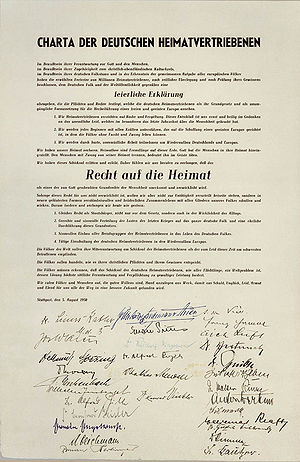
Due to the large number of expellees, their party-political preferences were important. When their own refugee parties were initially banned, a large share tended towards the "Sozialdemokratische Partei Deutschlands (SPD - Social Democratic Party of Germany), which at the time represented a strictly national line and was also well known for its older party traditions (e.g. in Bohemia). The SPD also quickly accepted former Bohemian Social Democrats into its ranks, where Richard Reitzner (1893-1962) from Marienbad (Czech: Mariánské Lázně) played a major role (cf. Müller, 57). The "Christlich-Soziale Union (CSU - Christian-Social Union), on the other hand, was regarded as Bavarian particularist and averse to foreigners; there were soon contacts here, too though, especially through the former Christian trade unionist Hans Schütz (CSU, 1901-1982) from Rumburg (Czech: Rumburk). However, the picture changed when first the "Wirtschaftsliche Aufbauvereinigung" (WAV - Economic Development Association), then the "Block der Heimatvertriebenen und Entrechteten" (BHE), founded in Schleswig-Holstein in 1950, had considerable success here as well (BHE: Landtag 1950: 12.3 % = 26 mandates; represented in the Landtag until 1962, also in the Bundestag 1953-1957; coalition partners in the Bavarian governments 1950/62). Theodor Oberländer (1905-1998), BHE Chairman in Bavaria and later in the FRG, 1953-1960 Federal Minister (CDU since 1956), and Walter Becher (1912-2005), 1954 chairman of the BHE parliamentary group in the Landtag, 1965-1980 member of the Bundestag (CSU since 1967), were leading representatives. Their party transfers also reflect the imminent decline of the BHE and the shift of expellees to the Union parties (now emphasising national heritage). However, expellees worked in all parties, often in high positions (e.g. the German Bohemian Walter Stain from Prague [1916-2001, BHE, Bavarian Minister of Labour 1954-1962], Hans Schütz, 1964-1966 Bavarian Minister of Labour; Volkmar Gabert [1923-2003, SPD, Remigrant], 1963-1972 SPD State Chairman). Unlike the parties, the initially highly important homeland associations were very active in various projects, such as the legislation on the equalisation of burdens, but they were pressure groups rather than a direct influence. In addition, their importance has been marginalised since the mid-1960s due to the new "Ostpolitik" and later the fall of the wall in 1989, but also due to the ageing of their members. It is still unclear to what extent they will play a convincing role in the future.
Representation and therefore involvement by the major parties, then also by the BHE, also meant protection against radicalisation, as a considerable proportion of expellees were characterised by not very well informed national, even nationalist, thinking. At the borders of the Reich, but above all as minorities in the neighbouring states (especially in the ČSR), the Germans had had to wage a stalling struggle for language, culture and political independence for a long time, parallel to the other ethnic groups, which later made them particularly susceptible to right-wing radical slogans (major successes of the Henlein Party as early as 1935 in the ČSR) and (after the country's occupation) often made joining the NSDAP seem totally natural. A clear national component was therefore also characteristic of many expellees after 1945. Also and especially among them, for a long time there was no profound discussion of the question of the antagonism of peoples and of their own guilt before and during the Nazi era.
Nevertheless, the overwhelming majority of expellees resolutely stuck to the Constitution and accepted the democratic ideals. This is demonstrated not only by their equal participation in state and federal politics, their distance from right-wing and left-wing radicals and their unconditional will to integrate. It is also made clear by the "Charter of German Expellees" adopted in Stuttgart on 5 August 1950, which on the one hand held fast to the right to one's homeland, on the other forbade any revenge and retaliation and proclaimed a united Europe as a goal. The Charter was formulated by key representatives of expellees, with the Baltic Germans and Sudeten Germans playing an important role. The Charter was criticised, partly seriously, partly tendentiously, for not commemorating German Nazi crimes and other victims, for renouncing retaliation, which was not granted to the expellees at all, for the fact that most of those responsible for the text had formerly belonged to the NSDAP (Schwartz, Funktionäre, 19-26), and for the fact that the document referred to the Christian Occident and natural law in its line of argument at all (Weger, Volkstumskampf, 465-476). This was countered by the fact that such criticism, applied from today's point of view to that time, was for the most part void: At that time, most elites belonged to the earlier ideological parties; the undoubtedly limited, but typical thinking of the time must be taken seriously. And the Charter not only prevented radicalisation among the expellees and promoted their integration into the new Europe (Douglas, 390), it also distinguished itself positively from the calls for revenge in the expelling states and their decades of abuse. It therefore remains a highly significant document. Of course, official principles did not prevent utopian and legally questionable considerations of return and revision efforts from being made für a long time to come.
Social and Cultural Relations

Social and cultural contacts were crucial in addition to accommodation and work. One important indicator are marriages between expellees and locals. Contrary to expectations, these happened very quickly. As early as 1953 there were only a good 40% pure marriages between expellees, whereby the lack of men caused by the war played a role. However, a small base of pure marriages between expellees remained in the long run (Bayern in Zahlen 9, issue 2). The spatial contact was not as close within the communities, which often designated apartments and building land for the new citizens in less favourable neighbourhoods or at a considerable distance from the old residential centre, which is often still recognisable today. Clubs and other associations, especially in the areas of music and sports, were important then: Expellees found easy access here and often became initiators of such activities due to their experience in these areas. The same German language and the shared fate over the last decades were undoubtedly fundamental for this. But it should also be noted that quite a few pure expellee alliances were also formed within and outside the organised homeland associations. Among the Sudeten Germans this was the very active "Egerländer Gmoi" or, in the case of factually oriented groups, the Social Democratic Seliger Community (after Josef Seliger [1870-1920]), the Catholic Ackermann Community and the nationally oriented Witiko Federation, which each cultivated their cultural traditions.
Integration or distance were also evident in other areas. In general the religious contact was relatively easy, since the Catholic Church hardly is regionally influenced – it was more difficult for Protestants. Initial problems with the use of pews, which were often rented out in Bavaria (leading to considerations of distinct church services) or cemeteries were quickly solved. As a result, many expellees first found a connection with their new homeland in the churches; however, there were also special expellee pilgrimages (Sudeten Germans, for example Vierzehnheiligen [Lichtenfels district], Silesians Andechs [Starnberg district]) and ecclesiastical centres (e.g. Catholic seminary in Königstein/Taunus) for a long time. Regional developments still need to be studied (cf. Stadtrecher). Quick assimilation also occurred in language. The old dialects have already largely died out as they were neither cultivated in schools nor by the state. Customs, especially traditional dress and festivals, were quite resistant in contrast, as they were also easier to pass on to the younger generation.
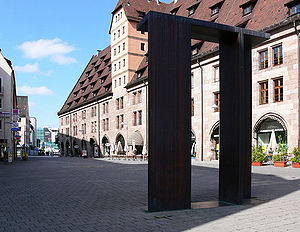
In other areas, there are ambiguities between initiatives and practical implementation. Undoubtedly most important were the consequences of the Federal Expellees Act of 1953, where the Bavarian State Secretary at the time, Theodor Oberländer, had succeeded in inserting a paragraph 96, which made the safeguarding and preservation of the expellees' cultural assets and their comprehensive use by appropriate institutions obligatory for the Federal Government and the individual states, which still applies today (Pohl, Integration, 326-361). This not only meant recognition of the high value of the East's cultural traditions but also a considerable amount of funding for various institutions, from museums to media work. Particularly noteworthy in the field of art is the important "Ostdeutsche Galerie" in Regensburg (opened in 1970, since 2003 "Kunstforum") and in the academic field the Collegium Carolinum in Munich, founded in 1956 as a successor to the Charles University in Prague, to research the history of the Bohemian states. In the concrete implementation, however, there were also often problems of an institutional and content-related nature, as can be seen in the example of the so-called "Ostkunde" (Eastern Studies) in school, which the BHE enforced for Bavaria in 1957. However, since it was introduced only as a teaching principle, not as a school subject, and then oscillated between memories of the old homeland, questionable political goals and general interest in Eastern Europe, it can hardly be said to have been very successful. It was similar in the case of the many sponsorships that Bavarian communities took on for home towns in the East, they are only rarely still filled with life today. Overall it was also a problem that the promotion of culture helped the expellees (in Bavaria especially through the cultural works of the Silesians in Würzburg, the Sudeten Germans and South-eastern Germans in Munich, the Bukovina Germans in Augsburg, the East Prussians in Ellingen), but their relations to the new homeland were only slightly strengthened: the new citizens kept among themselves to a large extent. This can also be seen in the still very limited contacts to established Bavarian regional history at university and academy; however, Karl Bosl (1908-1993), professor for Bavarian regional history, was also chairman of the Collegium Carolinum (1958-1980) for a long time and published the large "Handbuch der Geschichte der böhmischen Länder" (4 volumes, Stuttgart 1967/70 - Handbook on the History of Bohemian Countries). Munich medievalist Friedrich Prinz (1928-2003) dealt with the history of Bohemia as well as integration issues, and several Bavarian regional historians were significantly involved in the well-known publication series by the Ministry of Labour on "The Development of Bavaria through the Integration of Expellees and Refugees". Most writers and artists were not perceived as expellees (and often did not want to be); the symbolic figures of expellees, such as Stifter and Eichendorff, were far removed from symbols of Bavarian identity.
Finally, memoria in public is also scarce. Former refugee camps, for example, have been completely forgotten, and there are no memorials for them. And despite numerous streets being named after places in the old homeland and despite a multiplicity of memorials, above all at cemeteries, which also commemorate expellees in a mostly simple form, there are so far only very few central memorials to the expulsion (e.g. on the Hallmarkt in Nuremberg since 1999) and just a few impressive monuments (e.g. in Waldkraiburg and particularly in Neugablonz).
Integration Issues: Bavaria and the Expellees are Changing
If expellees have lost their earlier traditions in some areas but preserved them in others, then this can be called assimilation or non-assimilation. Integration, on the other hand, means that the new citizens incorporated themselves into the new circumstances but retained some of their own identity and at the same time partly changed the local society. There is no doubt that such integration has taken place in many areas in the host countries.
There were inevitable changes in Bavaria due to the influx of such a large number of people: All municipalities grew, some towns became large cities with over 100,000 inhabitants (e.g. Regensburg). The professional composition of the population also changed. Inevitably, it was also the end of previously denominationally closed regions (there were 1,564 unified communities in 1939, there were just nine in 1946), which contributed decisively to the end of the denominational school in Bavaria in 1968. However, the overall relationship of the confessions (Sudeten Germans mostly Catholic, Silesians partly Protestant) did not change. Industrial development was clearly driven forward, above all by the large number of small and medium-sized enterprises, some of them with special production; the traditional agility of the borderland Germans, which was now intensified in need, brought a breath of fresh air to working and professional life (least of all in rural areas, where they tended to intensify the rural exodus). Politically, cooperation in political parties and governments meant that Bavaria acted more strongly at pan-German level than in the past, defended the old borders of the Reich in the federal institutions (suit filed with the Federal Constitutional Court in 1973) and even got involved in disputes with ČSR, among other things over the Beneš decrees (President Eduard Beneš [1884-1948]). It is no wonder that in light of this importance of the new citizens the Bavarian state took over patronage of the Sudeten Germans, even calling them the fourth tribe besides Bavarians, Franconians and Swabians (1954/62), which is unique in Germany. Sponsorship for East Prussia was taken over in 1978. A study of the specific influence of expellees on Bavarian society (e.g. Politics: Herbert Hupka from Silesia [1915-2006], working at the "Bayerische Rundfunk" [Bavarian Broadcasting Company] and as a long-time member of the Bundestag [SPD/CDU]; Education: Wilhelm Ebert from Bohemia [born 1923], Chairman of the Bayerischer und Welt-Lehrerverband [Bavarian and World Teachers' Association]; Science: Dietmar Willoweit from Memel [born 1936], President of the Bayerische Akademie der Wissenschaften [Bavarian Academy of Sciences] 2006-2010) is needed.
But expellees have changed a great deal, too. First and foremost, they have not formed regional units since 1945. With the language and some other characteristics having been almost completely lost, they are increasingly becoming inhabitants of Bavaria in the "tribes" and dialects living here. Soon only a few considered returning to the East (which would have meant a return to communist dictatorships until 1989). Their old homeland was largely abandoned, especially by the younger generations. Cultural traditions, on the other hand, have survived and are passed on in a remarkable way, from the memories of their origins ("Heimatstuben") to the homeland associations with their centres and festivals (such as the "Sudetendeutsche Tag"), to new, now easily possible contacts with former home towns and countries of origin.
A new, pleasing development opens up here. It began, very slowly at first, with the improvement of state relations (with Poland since 1970, ČSSR since 1973), but has had a considerable impact on the younger generation in particular since 1989, both on the descendants of expellees and on the population of their former home countries, which is reflected in numerous personal, social and scientific contacts. For Bohemia, the opening of a permanent exhibition on "Our Germans" planned for 2021 in the municipal museum in Aussig is worth mentioning. On the national level, however, the path is still difficult, as the years of disputes over the "Dokumentationszentrum Flucht, Vertreibung, Versöhnung" (Documentation Centre Flight, Expulsion, Reconciliation) in Berlin (finally opened in June 2021) have shown. Hungary has been exemplary in this field in recent years, both towards the displaced Germans and those who remained in the country (introduction of a day commemorating the expulsion in 2012; financial support). If the positive development continues, the expellees' home countries will soon have a large number of representatives of their history and culture in Germany and will benefit from these approaches to a new symbiosis themselves.
History of Research
The historiography regarding expellees has not only seen its ups and downs (special interest until the end of the 1950s, repression until the 1980s, because the subject had been dealt with and seemed politically undesirable, then new attention in the context of general migration issues), it has also always been shaped and endangered by massive ideological and political influences (nationalism, Cold War, criticism of conservatism), some of which are still fighting against each other (e.g. Nawratil; Hahn). The dispute over a "Centre against Expulsions" in Berlin has brought about new discussions since 1999. It is therefore precisely in this area that we must work to ensure that all views presented in an appropriate manner are always given serious consideration.
The collection of historical data and examination of the subject began soon, both in Germany and Bavaria. Large source works (e.g. documentation of the expulsion) and a three-volume handbook (Lemberg-Edding) laid the groundwork until 1960. The activities by Professors Friedrich Prinz (Munich) and Rudolf Endres (Bayreuth, born 1936) were of particular importance for Bavaria, as was the publication series from the Ministry of Labour (Prof. Hermann-Joseph Busley [born 1930], Entwicklung Bayerns). Since the 1990s, the topic has primarily been examined across countries and social groups (e.g. Krauss, Integrationen; Teuchert, Gemeinschaft). The influence of well-known films (e.g. Grün ist die Heide, 1951; Heimatmuseum, 1988), which of course usually showed less the expulsion than the successful integration (Tiews, Fluchtpunkt), is also noteworthy. One pleasing development is that a proper handling of the events has meanwhile even begun in the former expelling states, with regard to both the expulsion itself and to the problems of reconstruction, for example in the borderlands of Poland and the Czech Republic. This also broadened German researchers' view to neighbouring areas (e.g. Bretschneider; Hofmann; Wiedemann), just as the establishment of the Euregions (e.g. Euregio Eger) has already done in the social sphere. Fundamental discussions on folklore and nation building, as they have been conducted for several decades, are also important. Expulsion as a secular process has found considerable interest in the public again as a result, although the earlier euphoria that integration had been totally successful tends to be called into question. In addition to scientific works and non-fiction books, there is a large number of books about the homelands and personal memoirs that should not be underestimated. They are collected by the libraries and archives at the Haus des Deutschen Osten and Sudetendeutschen Haus or the Bayerisches Hauptstaatsarchiv (Main State Archive of Bavaria), which also preserves the holdings of the Sudeten German Archive. It is also worth mentioning the many "Heimatstuben" (homeland museums) and homeland collections. Although these were built and equipped in the spirit of the post-war period, they offer excellent material for the individual expulsion regions, from letters and writings to pictures and traditional costumes (cf. Henker; Eisler); as more and more of these are being broken up today, following the end of the generation with personal experiences, special attention must be paid to the preservation the material in other places, such as archives and museums in Bavaria and Bohemia (Sauer, Nachrichten).
References
- Adrian von Arburg (Hg.), Als die Deutschen weg waren. Was nach der Vertreibung geschah: Ostpreußen, Schlesien, Sudetenland, Reinbek bei Hamburg 2007.
- Katharina Aubele, Vertriebene Frauen in der Bundesrepublik Deutschland. Engagement in Kirchen, Verbänden und Parteien 1945-1970, Göttingen 2018.
- Klaus J. Bade u. a. (Hg.), Enzyklopädie Migration in Europa, Paderborn 2007.
- Franz J. Bauer, Flüchtlinge und Flüchtlingspolitik in Bayern. 1945-1950 (Forschungen und Quellen zur Zeitgeschichte 3), Stuttgart 1982.
- Bayerisches Staatsministerium für Arbeit und Sozialordnung: Deportation, Flucht und Vertreibung. Ein Rückblick nach 40 Jahren, München 2. Auflage 1987; 1945-1995: 50 Jahre nach Flucht und Vertreibung. Hypotheken und Chancen, München 1995.
- Mathias Beer, Flucht und Vertreibung der Deutschen. Voraussetzungen, Verlauf, Folgen (Beck'sche Reihe 1933), München 2011.
- Rainer Bendel, Vertriebene - Katholische Kirche - Gesellschaft in Bayern 1945 bis 1975 (Die Entwicklung Bayerns durch die Integration der Vertriebenen und Flüchtlinge 12), München 2009.
- Detlev Brandes/Holm Sundhausen/Stefan Troebst (Hg.), Lexikon der Vertreibungen. Deportation, Zwangsaussiedlung und ethnische Säuberung im Europa des 20. Jahrhunderts, Wien/Köln/Weimar 2010.
- Uta Bretschneider u. a. (Hg.), Verordnete Nachbarschaften. Transformationsprozesse im deutsch-polnisch-tschechischen Grenzraum seit dem Zeiten Weltkrieg, Dresden 2016.
- Andrew Demshuk, The lost German East. Forced Migration and the Politics of Memory, 1945-1970, Cambridge 2012.
- R. M. Douglas, "Ordnungsgemäße Überführung". Die Vertreibung der Deutschen nach dem Zweiten Weltkrieg, München 3. Aufl. München 2012.
- Cornelia Eisler, Verwaltete Erinnerung - symbolische Politik. Die Heimatsammlungen der deutschen Flüchtlinge, Vertriebenen und Aussiedler, München 2015
- Stefan Ellenrieder, Wohnverhältnisse von Flüchtlingen und Heimatvertriebenen in München in der Nachkriegszeit, in: Oberbayerisches Archiv 120 (1996), 317-390.
- Rudolf Endres (Hg.), Bayerns vierter Stamm. Die Integration der Flüchtlinge und Heimatvertriebenen nach 1945 (Bayreuther Historisches Kolloquium: Bayreuther historische Kolloquien 12), Köln/Wien 1998.
- Michael von Engelhardt, Lebensgeschichte und Gesellschaftsgeschichte. Biographieverläufe von Heimatvertriebenen (Die Entwicklung Bayerns durch die Integration der Vertriebenen und Flüchtlinge 7), München 2001.
- Paul Erker, Vom Heimatvertriebenen zum Neubürger. Sozialgeschichte der Flüchtlinge in einer agrarischen Region Mittelfrankens 1945-1955, Wiesbaden 1988.
- Verena Feistauer, Eine neue Heimat im Kino. Die Integration von Flüchtlingen und Vertriebenen im Heimatfilm der Nachkriegszeit, Essen 2017.
- Elisabeth Fendl (Hg.), Der Sudetendeutsche Tag. Zur demonstrativen Festkultur von Heimatvertriebenen, Münster 2019.
- Hans Fenske, "Reiner Tisch wird gemacht werden". Die Vertreibung der Deutschen aus dem Osten, in: Historische Mitteilungen 17 (2004), 228-288.
- Angelika Fox u. a. (Hg.), Heimat verlieren, Heimat gewinnen, Eichstätt 2003.
- Karl-Ulrich Gelberg, Flüchtlinge und Flüchtlingspolitik, in: Max Spindler/Alois Schmid (Hg.), Handbuch der bayerischen Geschichte. 4. Band, 1. Teil, München 2. Auflage 2003, 737-757.
- David W. Gerlach, The Economy of ethnic Cleansing: The Transformation of the German-Czech Borderlands after World War II, Cambridge 2017.
- Thomas Grosser, Die Integration der Vertriebenen in der Bundesrepublik Deutschland. Annäherungen an die Situation der Sudetendeutschen … am Beispiel Bayerns, in: Hans Lemberg (Hg.), Im geteilten Europa. Tschechen, Slowaken und Deutsche und ihre Staaten 1948-1989, Essen 1998, 41-94 [wichtige Tabellen].
- Johann Handl/Christa Hermann, Soziale und berufliche Umschichtung der Bevölkerung in Bayern nach 1945 (Die Entwicklung Bayerns durch die Integration der Vertriebenen und Flüchtlinge 2), München 1994. [Mikrozensus 1971]
- Helge Heidemeyer, Flucht und Zuwanderung aus der SBZ/DDR 1945/1949-1961. Die Flüchtlingspolitik der Bundesrepublik Deutschland bis zum Bau der Berliner Mauer (Beiträge zur Geschichte des Parlamentarismus und der politischen Parteien 100), Düsseldorf 1994.
- Peter Heidler, Das Lager Hof-Nord 1945-1967, 2. Auflage Hof 2020.
- Michael Henker (Hg.), Die Heimatsammlungen der Sudeten- und Ostdeutschen in Bayern, München 2. Auflage 2009.
- Dierk Hoffmann/Marita Krauss/Michael Schwartz, Vertriebene in Deutschland. Interdisziplinäre Ergebnisse und Forschungsperspektiven (Sondernummer der Schriftenreihe der Vierteljahrshefte für Zeitgeschichte), München 2000.
- Andreas R. Hofmann, Die Nachkriegszeit in Schlesien. Gesellschafts- und Bevölkerungspolitik in den polnischen Siedlungsgebieten 1945-1948, Köln 2000.
- Gerhard Hopp, Machtfaktor auch ohne Machtbasis? Die Sudetendeutsche Landsmannschaft und die CSU, Wiesbaden 2010.
- Otto Kimminich, Der völkerrechtliche Hintergrund der Aufnahme und Integration der Heimatvertriebenen und Flüchtlinge in Bayern (Die Entwicklung Bayerns durch die Integration der Vertriebenen und Flüchtlinge 1), München 1993.
- Manfred Kittel, Bayerns "fünfter Stamm". Schlesien, Ostpreußen und viele andere Vertriebenengruppen im integrationspolitischen Vergleich mit den Sudetendeutschen, München 2010.
- Manfred Kittel, Vertreibung der Vertriebenen? Der historische deutsche Osten in der Erinnerungskultur der Bundesrepublik (1961-1982), München 2007.
- Andreas Kossert, Kalte Heimat. Die Geschichte der deutschen Vertriebenen nach 1945, München 2009.
- Marita Krauss, Die Integration Vertriebener am Beispiel Bayerns - Konflikte und Erfolge, in: Dierk Hoffman/ Michael Schwartz (Hg.), Geglückte Integration? Spezifika und Vergleichbarkeiten der Vertriebenen-Eingliederung in der SBZ/DDR (Sondernummer Schriftenreihe der Vierteljahreshefte für Zeitgeschichte), München 1999, 47-56.
- Marita Krauss, Integration und Akkulturation. Eine methodische Annäherung an ein vielschichtiges Problem, in: Mathias Beer/Martin Kintzinger/Marita Krauss (Hg.), Migration und Integration. Aufnahme und Eingliederung im historischen Wandel (Stuttgarter Beiträge zur historischen Migrationsforschung 3), Stuttgart 1997, 11-25.
- Marita Krauss u. a. (Hg.), Erinnerungskultur und Lebensläufe. Vertriebene zwischen Bayern und Böhmen im 20. Jahrhundert - grenzüberschreitende Perspektiven, München 2013.
- Marita Krauss (Hg.), Integrationen. Vertriebene in den deutschen Ländern nach 1945, Göttingen 2008.
- Eugen Lemberg/Friedrich Edding (Hg.), Die Vertriebenen in Westdeutschland. Ihre Eingliederung und ihr Einfluß auf Gesellschaft, Wirtschaft, Politik und Geistesleben. 3 Bände, Kiel 1959.
- Markus Mößlang, Flüchtlingslehrer und Flüchtlingshochschullehrer. Eine Studie zur Integration der Flüchtlinge und Vertriebenen im bayerischen Bildungswesen 1945-1961 (Die Entwicklung Bayerns durch die Integration der Vertriebenen und Flüchtlinge 8), München 2002.
- Matthias Müller, Die SPD und die Vertriebenenverbände 1949-1977. Eintracht, Entfremdung, Zwietracht, Berlin 2012.
- Heinz Nawratil, Schwarzbuch der Vertreibung 1945 bis 1948, München 8. Auflage 2000.
- Bernadetta Nitschke, Vertreibung und Aussiedlung der deutschen Bevölkerung aus Polen 1945 bis 1949, 2. Aufl. München 2004 (ursprünglich polnisch, 1999).
- Jiří Padevĕt, Blutiger Sommer 1945. Nachkriegsgewalt in den böhmischen Ländern, Leipzig 2020.
- Astrid Pellengahr, Vereinswesen als Integrationsfaktor. Eine Fallstudie zur Eingliederung der Vertriebenen und Flüchtlinge in Bayern nach 1945 (Die Entwicklung Bayerns durch die Integration der Vertriebenen und Flüchtlinge 10), München 2005.
- Bernhard Piegsa, Die Umsiedlung der Heimatvertriebenen und der Freistaat Bayern. Eine statistische Analyse mit einem Exkurs zur Vertriebenenumsiedlung in der sowjetischen Besatzungszone Deutschlands (Die Entwicklung Bayerns durch die Integration der Vertriebenen und Flüchtlinge 11), München 2009.
- Karin Pohl, Zwischen Integration und Isolation. Zur kulturellen Dimension der Vertriebenenpolitik in Bayern (1945-1975) (Die Entwicklung Bayerns durch die Integration der Vertriebenen und Flüchtlinge 13), München 2009.
- Friedrich Prinz, Die Integration der Flüchtlinge und Vertriebenen in Bayern. Versuch einer Bilanz nach 55 Jahren (Hefte zur Bayerischen Geschichte und Kultur 24), Augsburg 2000.
- Niels von Redecker, Die polnischen Vertreibungsdekrete und die offenen Vermögensfragen zwischen Deutschland und Polen, Frankfurt 2003.
- Vincent Regente, Flucht und Vertreibung in europäischen Museen: deutsche, polnische und tschechische Perspektiven im Vergleich, Bielefeld 2020.
- Maren Röger, Flucht, Vertreibung und Umsiedlung. Mediale Erinnerungen und Debatten in Deutschland und Polen seit 1989 (Studien zur Ostmitteleuropaforschung 23), Marburg 2011.
- Johannes Schellakowsky (Hg.), Integration und Erbe. Zum politischen, gesellschaftlichen und kulturellen Beitrag der Vertriebenen in Deutschland und Bayern im Auftrag der Stiftung Kulturwerk Schlesien, Würzburg 2005.
- Tobias Schönauer, Flüchtlinge und Vertriebene in Ingolstadt nach 1945. Dokumentation und Begleitkatalog zur Ausstellung vom 13. September bis 7. Dezember 2008 im Stadtmuseum Ingolstadt (Dokumentation zur Zeitgeschichte 7), Ingolstadt 2008.
- Daniel Schönwald, Integration durch eine Interessenpartei. Der Block der Heimatvertriebenen und Entrechteten in Bayern 1950-1981 (Münchener historische Studien, Abteilung Bayerische Geschichte 24), Kallmünz 2014.
- Stephan Scholz u.a. (Hg.), Die Erinnerung an Flucht und Vertreibung. Ein Handbuch der Medien und Praktiken, Paderborn 2015.
- Stephan Scholz, Vertriebenendenkmäler. Topographie einer deutschen Erinnerungslandschaft, Paderborn 2015.
- Michael Schwartz, Funktionäre mit Vergangenheit. Das Gründungspräsidium des Bundes der Vertriebenen und das "Dritte Reich", München 2013.
- Helmut Slapnicka, Die rechtlichen Grundlagen für die Behandlung der Deutschen und der Magyaren in der Tschechoslowakei 1945-1948, München 1999.
- Markus Stadtrecher, Nicht unter Fremden? Die Katholische Kirche und die Integration von Vertriebenen im Bistum Augsburg, Baden-Baden 2016.
- Matĕj Spurný, Der lange Schatten der Vertreibung. Ethnizität und Aufbau des Sozialismus in tschechischen Grenzgebieten, Wiesbaden 2019.
- Tomáš Staněk, Verfolgung 1945. Die Stellung der Deutschen in Böhmen, Mähren und Schlesien (außerhalb der Lager und Gefängnisse), Wien u. a. 2002 (ursprünglich tschechisch, 1996).
- Matthias Stickler, Ostdeutsch heißt gesamtdeutsch. Organisation, Selbstverständnis und heimatpolitische Zielsetzungen der deutschen Vertriebenenverbände 1949-1972, Düsseldorf 2004.
- Felix Teuchert, Die verlorene Gemeinschaft. Der Protestantismus und die Integration der Vertriebenen in die westdeutsche Gesellschaft (1945-1972), Göttingen 2018.
- Philipp Ther, Die Außenseiter. Flucht, Flüchtlinge und Integration im modernen Europa, Berlin 2017.
- Alina Laura Tiews, Fluchtpunkt Film. Integration von Flüchtlingen und Vertriebenen durch den deutschen Nachkriegsfilm 1945-1990, Berlin 2017.
- Bastian Vergnon, Die sudetendeutschen Sozialdemokraten und die bayerische SPD 1945-1978, Frankfurt 2017.
- Tobias Weger, "Volkstumskampf" ohne Ende? Sudetendeutsche Organisationen 1945-1955, Frankfurt 2008.
- Richard Winkler, Die Bayerische Landesanstalt für Aufbaufinanzierung, in: Christoph Daxelmüller/Stefan Kummer/Wolfgang Reinicke (Hg.), Wiederaufbau und Wirtschaftswunder. Aufsätze zur Bayerischen Landesausstellung 2009 (Veröffentlichungen zur Bayerischen Geschichte und Kultur 57), Augsburg 2009, 160-171.
- Alfred-Maurice de Zayas, Heimatrecht ist Menschenrecht. Der mühsame Weg zur Anerkennung und Verwirklichung, München 2001.
- Walter Ziegler, Die Integration der Flüchtlinge in Bayern, in: Schriften der Sudetendeutschen Akademie der Wissenschaften und Künste 23 (2002), 267-297.
Sources
- Adrian von Arburg/Tomáš Staněk (Hg.), Vysídlení Němců a proměny českého pohraničí 1945-1951. Dokumenty z českých archivů. Bisher 3 Bände, Středokluky 2010/11 [Die Aussiedlung der Deutschen und die Entwicklung des tschechischen Grenzlandes. Dokumente aus tschechischen Archiven. – umfangreiche Quellensammlung mit Einleitung, jeweils auch die Vertreibung umfassend].
- Bayerisches Staatsministerium für Unterricht und Kultus (Hg.), Beschlüsse, Gutachten, Empfehlungen und Richtlinien zur politischen Bildung und zur Ostkunde, München 1964.
- Hermann-Joseph Busley u. a. (Hg.), Die Entwicklung Bayerns durch die Integration der Vertriebenen und Flüchtlinge. Bisher 13 Bände, München 1993-2009. [Arbeitsministerium]
- Die Flüchtlinge in Bayern [Sonderzählung Oktober 1946]; Die Vertriebenen in Bayern [Eingliederung 1950] (Beiträge zur Statistik Bayerns 142 und 151), 1948/1950.
- Elisabeth Fendl, Aufbaugeschichten. Eine Biographie der Vertriebenengemeinde Neutraubling, Marburg 2006. [Auswertung von Interviews]
- Monika Glettler (Hg.), Landtagsreden zur bayerischen Vertriebenenpolitik 1946-1950, München 1993.
- Hryciuk Grzegorz u. a., Umsiedlungen, Vertreibungen und Fluchtbewegungen 1939-1959. Atlas zur Geschichte Ostmitteleuropas, Bonn 2012. [nur Polen und Ostgebiete des Reiches]
- Roland J. Hoffmann (Hg.), Odsun. Die Vertreibung der Sudetendeutschen. 2 Bände, München 2000/2010. [Wichtiges Supplement zum zweiten Band, bearbeitet vom gleichen Autor.]
- Annelie Hopfenmüller, Integration von Flüchtlingen und Vertriebenen in Bayern nach 1945. Ausgewählte Dokumente aus dem Bayerischen Hauptstaatsarchiv (Kleine Ausstellungen Staatliche Archive Bayerns 29), München 2007.
- Wolfgang Jaenicke, Vier Jahre Betreuung der Vertriebenen in Bayern 1945-1949. Ein Bericht über den Stand der bisherigen Eingliederung und über ungelöste Probleme anlässlich des 4. Jahrestages der Errichtung der bayerischen Flüchtlingsverwaltung, München 1950.
- Jahrbuch für Volkskunde der Heimatvertriebenen 1 (1955)-6 (1961/62), dann Jahrbuch für ostdeutsche Volkskunde 7 (1962/63)-36 (1993/94), seit damals Jahrbuch für deutsche und osteuropäische Volkskunde 37 (1994/5) ff. [Zeitschrift]
- Martin Kornrumpf, In Bayern angekommen. Die Eingliederung der Vertriebenen. Zahlen, Daten, Namen, München 1979.
- Martin Kornrumpf, 46 Protokolle 1946 bis 1950. Flüchtlingsausschuß des Bayerischen Landtags, Gräfelfing 1981.
- Gertrud Krallert-Sattler, Kommentierte Bibliographie zum Vertriebenen- und Flüchtlingsproblem in der Bundesrepublik Deutschland, in Österreich und der Schweiz, München 1989.
- Friedrich Prinz (Hg.), Integration und Neubeginn. Dokumentation über die Leistung des Freistaats Bayern und des Bundes zur Eingliederung der Wirtschaftsbetriebe der Vertriebenen und Flüchtlinge und deren Beitrag zur wirtschaftlichen Entwicklung des Landes. 2 Bände, München 1984.
- Gerhard Reichling, Die deutschen Vertriebenen in Zahlen. 2 Bände, Bonn 1986/89.
- Theodor Schieder (Hg.), Dokumentation der Vertreibung der Deutschen aus Ostmitteleuropa. 8 Bände, 1954/1961, ND 1984.
- Sarah Scholl-Schneider u. a., Sudetské příbĕhy - Sudetengeschichten. Vertriebene - Alteingesessene - Neusiedler, Prag 2010. [zweisprachig]
- Robert Simon/Martina Fleischmann/Walter Bauernfeind u. a., Die Entwicklung Bayerns durch die Integration der Heimatvertriebenen und Flüchtlinge. Gemeinsames durch das Staatsministerium für Arbeit, Familie und Sozialordnung initiiertes Forschungsprojekt der bayerischen Landesuniversitäten. 6 Bände, Bayreuth 1990-1994. [letzter Band 4,3: Abschlussbericht mit Bibliographie und Quellenbestandsübersicht]
- Stellungnahme der Gemeinsamen deutsch-tschechischen Historikerkommission zu den Vertreibungsverlusten, in: Soudobé dějiny 3 (1996), 600-603.
- Vertreibung und Vertreibungsverbrechen 1945-1948. Bericht des Bundesarchivs vom 28. Mai 1974, Bonn 1989.
- Ulrich Völklein, "Mitleid war von niemand zu erwarten". Das Schicksal der deutschen Vertriebenen, München 2005. [Erlebnisberichte in der neuen Heimat]
- Jun Wilhelm, Die Vertreibungs-Transporte des Jahres 1946: eine zusammenfassende statistische Darstellung [aus der ČSR, Österreich und Ungarn in die amerikanische und sowjetische Besatzungszone], Augsburg 2009.
- Walter Ziegler (Hg.), Die Vertriebenen vor der Vertreibung. Die Heimatländer der deutschen Vertriebenen im 19. und 20. Jahrhundert. Strukturen, Entwicklungen, Erfahrung. 2 Teile (Die Entwicklung Bayerns durch die Integration der Vertriebenen und Flüchtlinge 5), München 1999.
Further research
External links
Related articles
- Landsmannschaften (nach 1945)
- Sudetendeutsche Landsmannschaft
- Ukrainische Freie Universität
- United Nations Relief and Rehabilitation Administration (UNRRA)
- Vertriebenengemeinden und -siedlungen
- Vertriebenenverbände
Alternative titles!
Cite
Walter Ziegler, Refugees and expellees, published 6 September 2011, english version published 9 March 2020; in: Historisches Lexikon Bayerns, URL: <https://www.historisches-lexikon-bayerns.de/Lexikon/EN:Refugees_and_expellees> (05.12.2025)
